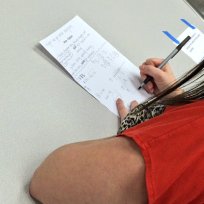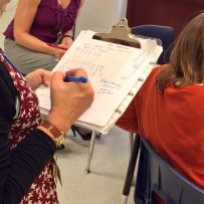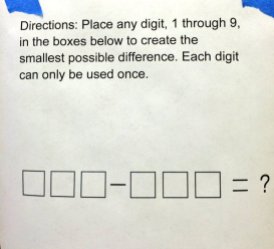
This year I have been leading a cohort of elementary math educators in my district. We met for two full days in July – you can read about that here and here – and throughout this school year we’ve met every other Thursday after school.
In December, our meeting focused on the work of Robert Kaplinsky, specifically his IGNITE talk about productive struggle and his website openmiddle.com.
At the start of the session, everyone reflected on what “productive struggle” means to them. This is important because as certain phrases become popular in education, they quickly become jargon. I wanted to ensure everyone had a chance to think about how they interpret the phrase and share that with the group. Then we watched Robert’s IGNITE talk.
The image that stood out most to me from his talk was the one of the mom riding the bike for her child. It seems so silly, and yet there are many instances as teachers where we can find ourselves doing the thinking for our students instead of letting them try either on their own or with our support.
At the end of the video, Robert puts out a call to action for teachers to create opportunities for students to productively struggle. And why not start by having the Math Rocks participants do some productive struggling of their own? Regina and I posted 10 problems around the room. We let everyone loose to do some math for 15 minutes. They dove right in!
All 10 problems came from openmiddle.com. If you aren’t familiar with the open middle problem type, here’s a brief summary: (You can learn more here.)
- they have a “closed beginning” meaning they all start with the same initial problem
- they have a “closed end” meaning that they all end with the same answer
- they have an “open middle” meaning there are multiple ways to approach and ultimately solve the problem
After debriefing as a group and sharing information about open middle problems, we came back around to the idea of productive struggle with this video from Michael Pershan. The whole thing is interesting, but for the purposes of our discussion, we watched the first 30 seconds of the video, and then we watched from 1:45 to 5:45.
By this point, we had made our case and it was time for the participants to take a stab at designing their own open middle problems. They had a choice of writing one from scratch or taking an existing problem from our curriculum and redesigning it as an open middle problem. A nice surprise is that our adopted textbook, Stepping Stones, already uses open middle problems in many lessons and activities! They don’t name them as such, but that’s essentially what they are.
We shared out the open middle problems they wrote. Afterward we gathered them together in this document if you’d like to see our first attempts. We closed the session with their homework assignment – giving their students an open middle problem and reflecting on it in a blog post. If you’re interested in learning more about open middle problems – especially learning from teachers trying them out for the first time! – check out our open middle blog post collection.
The consensus from the group seems to be that they can initially throw kids off if they’re not used to being asked questions like this, especially for those kids who want to neatly and easily come to the correct answer, but the questions provide opportunities for the type of thinking and struggling we want our students to engage in and we need to be using them more often.








This is a wonderful idea! Thanks for sharing! I used open middle in my classroom last year & think it is a wonderful way to create a productive struggle. This gives me an idea when thinking about my teachers… 🙂
Thank you!
I’ve used these kind of questions on our block days for an activity/break, but they don’t relate to the content we’re covering. Do you picture it like this? Random questions, or related to the curriculum currently being covered?
Good question! I specifically tasked them with creating and using a problem that was related to a current unit of study. They could also use them when doing spiral review of previously-taught concepts.
These types of questions may be just what I want. Thanks. I had no idea that was a thing. I always appreciate problems with multiple entry points and strategies. What caught my eye most however, was when you said you had a textbook. Color me jealous.
Happy to introduce them to someone else!
Does your district not have a textbook at all? Is it all just teacher-created lesson plans?
We are given a pacing guild with nothing but Common Core standards listed by letters and numbers with absolutely no words. We are on our own to figure out what they want and where we are to get it. It’s exhausting. There are old pre-common core books that are more than 10 years old that do not align with much of what we do.
Wow, that sounds incredibly unhelpful. What resources have you been going to for help? Off the top of my head I think of the Eureka Math curriculum that was written for Common Core. (You can also find it as Engage NY) Unless things have changed, the entire curriculum is completely free. Whether you’ll like it or not is another issue, but if you haven’t checked it out, I highly recommend it because it’s going to give you a huge leg up from the current resources you’re being provided.
Thanks for the tip on Eureka. I’m checking it out.
Great! If you have a chance, let me know what you think. I’m in Texas, so we have our own standards so I haven’t used that curriculum. I’d be curious to hear your thoughts.
Thank you so much for this post. I have a department meeting to run Wednesday morning and I am going to lead my time with the Ignite talk. I hope to generate some serious reflection and discussion in the room.
That’s great to hear! I hope they enjoy it. I thought Robert did a great job with that one.
Well this is certainly a cool post to read. Thank you so much for writing this up. It is really validating to read about how the ideas of productive struggle and Open Middle problems resonate with other math educators. I really like how you structured the day. I bet the teachers experienced first hand how challenging it can be to create a satisfying Open Middle problem and all the math you learn along the way in constructing one. Please have those teachers submit their problems on the site so we can include them! http://www.openmiddle.com/submit.
My pleasure! The conversations when we met again to share experiences about using them in the classroom was very enlightening. Some of the teachers found that their kids freaked out a bit at the open nature of the problems, which reinforced the need to provide these kinds of problems more often. It was great to hear that they saw the value in them despite initial implementation problems. I will definitely let them know they can share their own problems on the Open Middle site!
This has made my day. I wish all posintgs were this good.
Pingback: 18 Amazing Things | Teaching to the Beat of a Different Drummer